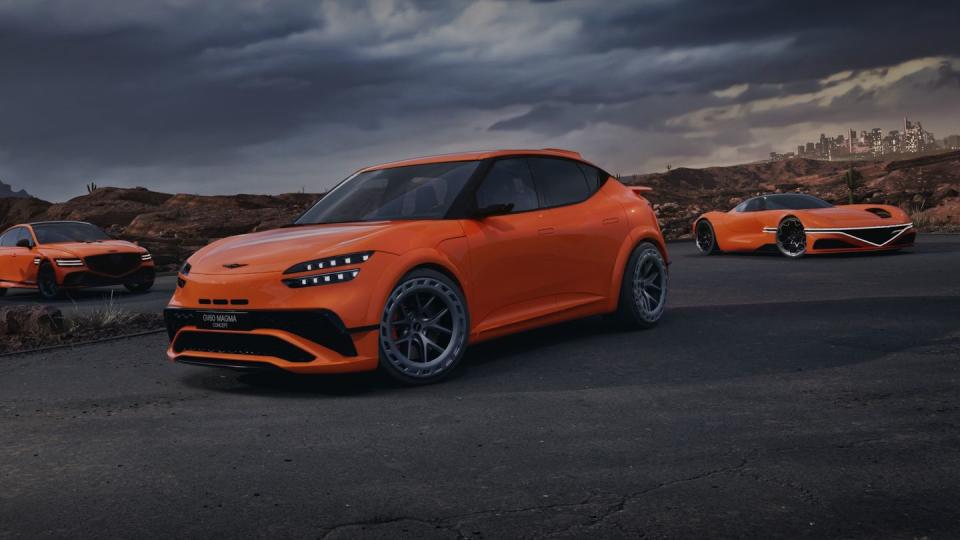Genesis’ Magma Models Are about Looks—and Performance, Too

Genesis is aiming to dive further into its performance roots with a new US-bound concept known as the Genesis GV60 Magma.
Based on the current GV60 and Hyundai Ioniq 5, the Magma version features a wider, more aggressive stance and wind tunnel-tested aerodynamics.
In conversation with Genesis Chief Creative Officer Luc Donckerwolke, we learn that the Magma is supposed to split the difference between performance and style.
To say Genesis has been flirting with performance for eight years now would be to betray the budding relationship that already exists inside the Korean luxury brand. Sure, the brand is largely focused on providing a lush sensory experience for its customers, but the mechanics that lie underneath aren't tuned simply for smoothness.
Take the 2024 Genesis G70 we tested on track at the Apex Motor Club. Its target audience likely hugs the middle lane for most highway jaunts, but the prevalence of torquey-turbocharged low-end makes the compact sedan a spirited partner. Rear-drive variants also seem to rotate around their rear axis with a degree of eagerness, for what that is worth.

But creating an ethos of performance is about more than EV boost buttons and middling horsepower numbers. In fact, qualifying performance is most often about feeling, both in your wheel-moving hands and in how it feels to peer at the shape. And if Genesis is good at one thing, it is bringing a diversity of effortlessly subtle shapes to the road.
This prowess is owed in part to Genesis Chief Creative Officer Luc Donckerwolke. With a multi-decade career spanning across the entire Volkswagen Group spectrum, Donckerwolke became chief creative officer for Hyundai Motor Group and the Genesis brand back in 2020.
Under his watch, the Genesis brand has thrived, as Donckerwolke's touch is connected to popular models like the full-size Genesis GV80 and sleek Genesis G90 executive sedan. But now, in conjunction with the New York International Auto Show, the head designer explains the evolution of Genesis' first set of true performance models.
"Genesis Magma presents an exciting opportunity to push the boundaries of performance and luxury for new interpretations in high-performance vehicles, with the ultimate goal of developing models exclusive to Genesis," said Donckerwolke.
Revealed as forward-looking concepts, a set of fiery orange slathered models are surrounded by shin-level glass as Donckerwolke talks. Known as the GV60 Magma and G80 Magma, these concepts simply ride on their original platforms. Without many mechanical details from Genesis, it's hard to say how spirited these will truly be.

Plus, US customers won't reap the benefit of Genesis' brightest executive sedan yet, as the G80 Magma will only be sold in Middle Eastern markets. From a business perspective, this makes sense, given the relatively low market share represented by executive sedan purchases domestically. Compact, electric hatchbacks are a different story.
That's why Genesis has committed to bringing the GV60 Magma to the US, building on the success of the compact crossover and its Hyundai sibling, the Ioniq 5. Notably, the GV60 Magma diverges from its traditional look in favor of a wider mouth (for improved battery cooling) as well as adding front-end canards and wider fenders across its wheelbase.

Even under the fluorescent glow of the Javits Center, the GV60 Magma is sitting pretty with its titanium-colored flow-formed, aero disc-integrated 21-inch wheels. Hidden from the side profile, the aero disc formation adds a further reach of road presence, belying the traditional meekness of size exhibited by many compact crossovers.
Wrapping the aggressive package together is a stately wing that is fed air through a set of fins on the rear hatch. Donckerwolke confirms that all of these stability-focused features have been developed using wind tunnel simulations, and they do functionally provide downforce.
Make no mistake, the Genesis Magma products are performance vehicles, but Donckerwolke emphasized that these aren't track vehicles, either. In remaining true to its brand image, Genesis is banking on a consumer as concerned with style as sporting ability, it seems.
"While speed and performance are important, the Genesis Magma program will look beyond, prioritizing the driving experience to kindle the joy of sporty driving with effortless comfort," Donckerwolke explained. "It's not a pocket rocket."
It's worth noting that Genesis' Magma lineup isn't supposed to be the equivalent of Hyundai's N brand performance wing. As Hyundai's Ioniq 5 N is set to hit dealerships in short succession, Genesis' performance models will function as top-of-the-line models instead of making up a whole new branch of the luxury brand.

It could make sense for Genesis to carry over hardware and software from the drift-happy Ioniq 5 N, but neither brand has confirmed this. Even so, the GV60 Magma will be fitted with an interior meant to split the difference, particularly in its seating choices. Body-colored bucket seats are available, though less aggressive comfort seats will be available, too.
"Comfort in a sporty vehicle is basically lateral support," Donckerwolke said. "The morphology of all drivers will be different from customer to customer and from continent to continent. It is almost a science."
Queried about the potential sales makeup of the GV60 Magma, he says it's unlikely the production numbers will be limited. Without pricing details and production timelines, tangible market comparisons remain limited, though Donckerwolke estimates the Magma would make up around 10% to 15% of model sales.
Before heading off, the head designer imparts another bit of knowledge, noting the GV60 Magma would be offered in other colors. Its namesake colorway will stick around, but the normal palette of colors will also be available for purchase. Even so, we hope to see a few more orange cars out on the road soon enough.
What kind of performance vehicles would you like to see from Genesis in the future? Please share your thoughts below.

 Yahoo Autos
Yahoo Autos 